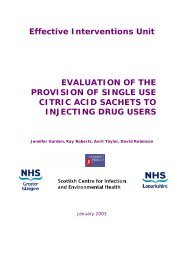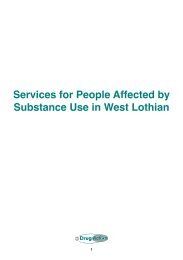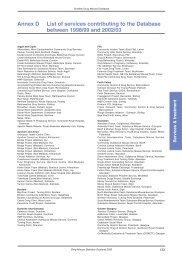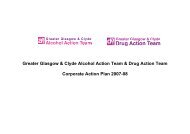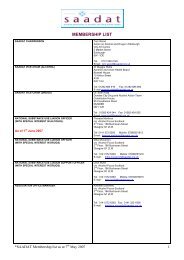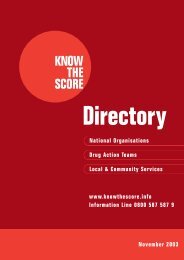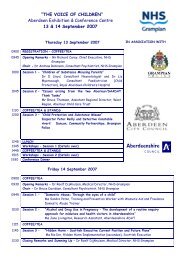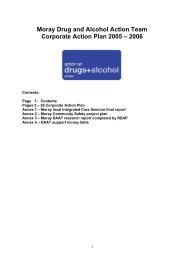inverclyde and drugs - Drug Misuse Information Scotland
inverclyde and drugs - Drug Misuse Information Scotland
inverclyde and drugs - Drug Misuse Information Scotland
You also want an ePaper? Increase the reach of your titles
YUMPU automatically turns print PDFs into web optimized ePapers that Google loves.
Inverclyde Forum About <strong>Drug</strong>s<strong>inverclyde</strong> <strong>and</strong> <strong>drugs</strong>A SnapshotReview of <strong>Drug</strong>-related Statistics <strong>and</strong> other Relevant Data in Inverclyde
contentsiiiiiiivAcknowledgmentsGlossary of TermsExecutive SummaryPreface1 Introduction2 Section One: Demographics <strong>and</strong> socialdeprivation5 Section Two: <strong>Drug</strong> prevalence in the area9 Section Three: <strong>Drug</strong> trends in the area13 Section Four: Services available withinInverclyde19 Section Five: Gaps <strong>and</strong> omissions in serviceprovision within Inverclyde20 Recommendations <strong>and</strong> conclusions24 References
acknowledgementsThis report was made possible due to the input ofa number of individuals, groups <strong>and</strong> agencies, whosecontribution we gratefully acknowledge.In particular we are grateful to our colleagues in thefour Community Forums, without whom IFAD wouldnot exist. We extend our gratitude, also, to our othercolleagues in the community - Open H<strong>and</strong>s FamilySupport Group, the Habit Group, Mid Oak FamilySupport Group, Haven, Valiant United <strong>and</strong> Lydia fortheir interest <strong>and</strong> support.We also acknowledge the support <strong>and</strong> help we havereceived from workers in our local agencies <strong>and</strong>express our thanks to Inverclyde Council, Argyll <strong>and</strong>Clyde Alcohol <strong>and</strong> <strong>Drug</strong> Team <strong>and</strong> the InverclydeRegeneration Partnership.Our thanks also go to the Scottish <strong>Drug</strong> Forum fortheir invaluable support, advice <strong>and</strong> involvementthroughout the lifetime of this project.Finally, we extend our thanks to the agencies for givingus their reports <strong>and</strong> information - Argyll <strong>and</strong> ClydeHealth Board, Community <strong>Drug</strong>s Team, StrathclydePolice <strong>and</strong> ISD Scotl<strong>and</strong>.Fay Rodgers,Jim Grieve,Isabel Berry <strong>and</strong>Eleanor Robertson,IFAD Working Group, October 2000.i
Inverclyde Forum About <strong>Drug</strong>sglossary of termsCDTCPNGPIDUsCommunity <strong>Drug</strong>s Team (CDT is the localsocial work community drug service basedin Greenock <strong>and</strong> provides a service toindividuals <strong>and</strong> their families, <strong>and</strong> to thecommunity as a whole)Community Psychiatric NurseGeneral PractitionerInjecting <strong>Drug</strong> UsersIFAD Inverclyde Forum About <strong>Drug</strong>s -Community Group established by localpeople on the Social InclusionPartnership's community Forum to tacklethe problems associated with <strong>drugs</strong>misuse.IFAD A sub Group of IFAD which takes forwardWorking project proposals.GroupIRP Inverclyde Regeneration Partnership -Inverclyde's Social Inclusion Partnership.ISD<strong>Information</strong> <strong>and</strong> Statistics Division ('ISDis responsible for the collection, processing<strong>and</strong> dissemination of statistical informationrequired for planning, management <strong>and</strong>monitoring of the Health Service inScotl<strong>and</strong>’)SCIEHSDMDSIPSPSScottish Centre for Infection <strong>and</strong>Environmental ('SCIEH is responsible forthe national surveillance of communicablediseases <strong>and</strong> environmental health hazards<strong>and</strong> the provision of expert operationalsupport on infection <strong>and</strong> environmentalhealth to health boards <strong>and</strong> localauthorities in Scotl<strong>and</strong>’).Scottish <strong>Drug</strong>s <strong>Misuse</strong> Database (’Thedatabase provides anonymous data aboutnew problem drug users who attendspecialist drug services i.e. statutory <strong>and</strong>non-statutory drug agencies <strong>and</strong> generalpractitioners’).Social Inclusion Partnership (’AGovernment initiative geared to bringtogether the statutory, voluntary,community <strong>and</strong> private sectors tocollectively find social, environmental <strong>and</strong>economic solutions to complex <strong>and</strong> deeprooted problems such as unemployment,poor skills, low incomes, poor housing,high crime environments, bad health <strong>and</strong>family breakdown’).Scottish Prison ServicePPAPriority Partnership Area (Areas whichhave been identified for social inclusioninput due to a concentration of multipleproblems)ii
Inverclyde Forum About <strong>Drug</strong>sexecutivesummaryThis report is a summary of the most currentinformation relating to <strong>drugs</strong> in the Inverclyde area.It has been commissioned by the Inverclyde Forumabout <strong>Drug</strong>s (IFAD) in order to help inform debateabout the extent of drug misuse in Inverclyde, whatgaps there are in existing services <strong>and</strong> whatrecommendations there are to improve services.Inverclyde is one of the poorest local authority areasin Scotl<strong>and</strong>. 14.3% of households in the area couldbe categorised as multiply or severely deprived. OnlyGlasgow <strong>and</strong> Dundee are worse than Inverclyde.21% of Inverclyde's population live in postcode sectorsamongst the worst 10% in Scotl<strong>and</strong>. 47% of the totalpopulation of Inverclyde are living in or on the marginsof poverty. Inverclyde had the second highest mortalityrate of all local authority areas in Scotl<strong>and</strong>.A survey commissioned by Argyll <strong>and</strong> Clyde HealthBoard in 1995 estimated that there were 562 injectingdrug users in Inverclyde; this made up 40% of theestimated total for all of Argyll <strong>and</strong> Clyde at that time.There has been no follow-up survey, but evidencefrom drug agencies <strong>and</strong> other organisations wouldsuggest that the number of injectors has increasedsince the survey was last carried out.It is estimated from this figure of 562 injectors thatthey will spend a total of just over twelve-<strong>and</strong>-onequartermillion pounds per year to sustain their drugmisuse. This works out at £420 per week per injectingdrug user. As the overwhelming majority of injectorsare unemployed almost all of the monies to obtainillicit <strong>drugs</strong> will be obtained by criminal means.Figures about drug misuse in Inverclyde are obtainedfrom a number of sources. These include the localcommunity drug team, 2 needle exchange servicesin the area, a local prescribing service, police data <strong>and</strong>the national Scottish <strong>Drug</strong>s <strong>Misuse</strong> Database.In 1998-99 4% of all submissions to the <strong>drugs</strong> misusedatabase came from Inverclyde. Just over a quarterof all submissions to the database from Argyll <strong>and</strong>Clyde came from Inverclyde.The vast majority of new clients, 79%, attending <strong>drugs</strong>ervices in Inverclyde are using heroin. This figure issubstantially above the figure for all of Scotl<strong>and</strong>, whichst<strong>and</strong>s at 53% of new clients using heroin <strong>and</strong> issignificantly greater than that for other areas of Argyll<strong>and</strong> Clyde.50% of new clients attending drug services inInverclyde are injecting which again is higher than theScottish figure of 38%. New clients attendingInverclyde drug services are marginally more likely tobe sharing injecting equipment.63%, or 10 out of 16 drug-related deaths recordedby Strathclyde Police in the divisions serving Argyll<strong>and</strong> Clyde during 1998-99 were in Inverclyde.Inverclyde accounted for 10% of drug-related deathsin the Strathclyde Force area in 1998-99.A survey conducted at Gateside Prison in Greenockduring 1996 reported that 101 out of 115 prisonersinterviewed (88%) had taken <strong>drugs</strong> in the communitywhile 70 or 68% reported that they had taken <strong>drugs</strong>both in prison <strong>and</strong> the community.There are a wide range of gaps <strong>and</strong> omissions inservice provision for drug misusers in the area.iii
These include:• Lengthy waiting lists for prescribing of methadone.• Lack of residential rehabilitation services in thearea.• A total absence of either through-care or aftercareservices for drug users stabilised on methadoneor recovering from drug misuse.• Strains on pharmacies in the area as a result ofthe large numbers of methadone patients gettingtheir methadone on daily supervision, leading totensions between staff <strong>and</strong> clients.• The need for more services to engage with youngpeople in the area.• There is a need to look at how effective drugtreatment services are within the area.Overall, it is recommended that there be a strategicplan in relation to <strong>drugs</strong> which is inclusive <strong>and</strong> involvesall interested parties in Inverclyde including the localauthority, the health board, addiction services, police,service users, community groups (including familysupport groups <strong>and</strong> carers) <strong>and</strong> others. Such a planwould seek to look at practical, feasible ways to dealwith the immense social problems surroundingaddiction in Inverclyde <strong>and</strong> offer the best ways ofworking together to overcome the serious gaps <strong>and</strong>omissions in service provision in the area.prefacePreface by Dr David Bell Consultant in Public Health Medicine for Argyll<strong>and</strong> Clyde Health BoardAs our research progressed <strong>and</strong> we realised theenormity of the size <strong>and</strong> shape of the problemsconfronting us we might readily have ab<strong>and</strong>oned ourproject had we not been reminded of two stories ofelephants recounted to us when our enthusiasm wasflagging.The first is of the elephant <strong>and</strong> the five blind men.One said 'the elephant was like a wall'; one said 'likea tree trunk'; one said 'like a rope'; one said 'like asnail'; <strong>and</strong> one said 'like a pipe'.The sighted observer perceived that they had holdof, respectively, the elephant's side, leg, tail ear <strong>and</strong>trunk.The other story reminds us not to get daunted bythe enormity of the task ahead.The question is 'How do you eat an elephant?' Andthe answer -'One bite at a time!' Start somewhere: where tostart doesn't matter that much.I wish IFAD the very best in its efforts in this vitalfield.David Belliv
introductionInverclyde Forum About <strong>Drug</strong>s (IFAD) was launchedin 1998 as an informal <strong>and</strong> loose grouping ofcommunity forum members in Inverclyde who wereinterested in tackling <strong>drugs</strong> misuse <strong>and</strong> related issuesin the area. From initial discussions held by groupmembers it soon became clear that it was difficult toget a h<strong>and</strong>le on local drug problems as there was alack of easily available local information which thecommunity could use as evidence to back their case.IFAD therefore set up a Working Group to look atresearch needs. After much debate <strong>and</strong> discussion,the Working Group came to the conclusion thatbefore any new research into the subject could becommissioned, there was a need to pull together allavailable local information, collate it <strong>and</strong> see what thepicture was for Inverclyde.injecting, an estimate of the cost of drug misuse inInverclyde, <strong>and</strong> numbers attending services in thearea. Section three examines drug trends in the area<strong>and</strong> how they compare with elsewhere in Scotl<strong>and</strong>.Section four gives a detailed examination of all <strong>drugs</strong>ervices in the area including local authority, healthboard <strong>and</strong> community groups. Finally section fivelooks at the gaps in services dealing with drug misusein Inverclyde.The purpose of this report is to provide a snapshotof the current situation in Inverclyde as it relates to<strong>drugs</strong> misuse <strong>and</strong> to inform a constructive debate onhow best to proceed in attempting to overcome theproblems caused by <strong>drugs</strong> misuse in the area.A successful bid was made to the Social InclusionPartnership (SIP) for a one-year research <strong>and</strong> supportworker project in March 1999. The Working Grouptook on the task of managing <strong>and</strong> delivering theproject which began in May 1999.Five months into the project the Working Group hadto contend with the project worker unexpectedlyleaving. The Scottish <strong>Drug</strong>s Forum was commissionedto complete the work.This report is a compilation of local informationrelating to <strong>drugs</strong> in the Inverclyde area. The reportis divided into five sections. Section one looks at theoverall population profile of Inverclyde with a specialemphasis on social deprivation in the area. Sectiontwo looks at the overall levels of drug misuse inInverclyde; the numbers misusing <strong>drugs</strong>, levels of1
Inverclyde Forum About <strong>Drug</strong>ssection one:demographics <strong>and</strong>social deprivationThe Argyll <strong>and</strong> Clyde Health Board area, which coversInverclyde, represents the largest geographical areaof any health board in Scotl<strong>and</strong>. Argyll <strong>and</strong> Clyde alsoincludes the largely rural areas of Argyll <strong>and</strong> Bute,Cowal Peninsula <strong>and</strong> isl<strong>and</strong>s such as Islay <strong>and</strong> Mull. Italso has four main urban centres of population, theseare parts of West Dunbartonshire <strong>and</strong> EastRenfrewshire, Renfrewshire <strong>and</strong> of course Inverclydewhich represents Port Glasgow, Greenock <strong>and</strong>Gourock. In the year ending 31st March 1999 therewere 1569 submissions to the Scottish <strong>Drug</strong>s <strong>Misuse</strong>Database (see p8) from the entire Argyll <strong>and</strong> ClydeHealth Board area (1). Of this 26% were fromInverclyde; thus just over a quarter of all new clientsto services came from this area. We will look in detailat the drug trends <strong>and</strong> patterns in later sections.Inverclyde comprises the three towns of Greenock,Port Glasgow <strong>and</strong> Gourock as well as a rural hinterl<strong>and</strong>.According to the 1991 UK population censusInverclyde has a population of 87,268. The numberof households in the area is 37,200 <strong>and</strong> the rate ofowner occupation is 18,600. The public sector housingstock, i.e. council houses, comprises 13,434 dwellings.In addition there are 2,600 private sector <strong>and</strong> housingassociation rented properties. Therefore 50% ofhouseholders are in owner occupation, 43% arepublic sector housing or private rentedaccommodation. (2)In 1995 it was estimated by the Social WorkDepartment that there were 2,509 vulnerable childrenliving in Inverclyde or 12% of children aged 15 years<strong>and</strong> younger. (3)Inverclyde is one of the poorest local authority areasin Scotl<strong>and</strong>. Analysis of the 1991 population censuscarried out for the Scottish Office revealed that14.3% of households could be categorised as multiplyor severely deprived. Only Glasgow (16.0%) <strong>and</strong>Dundee (14.5%) are worse than Inverclyde. Morerecent analysis has shown that the poverty map ofScotl<strong>and</strong> has not changed greatly since the 1991census. Research carried out for the Scottish Officein 1998 showed that 21% of Inverclyde's populationlive in postcode sectors amongst the worst 10% inScotl<strong>and</strong> in terms of social deprivation. (4)The 1996 annual report from the Director of PublicHealth for Argyll <strong>and</strong> Clyde Health Board revealedthat Inverclyde had the second highest mortality rateof all local authority areas in Scotl<strong>and</strong>. Only GlasgowCity had a higher figure. (5)People in Inverclyde also experience poorer healththroughout their lives. Once more, data from the1991 census indicates that over 10% of Inverclyderesidents under the age of 65 reported having a longtermillness; this is twice the rate for the UK widefigure for this age group. (6) An indicator of risk tothe health of infants is low birth weights; theproportion of babies in Inverclyde in this category isaround 20% higher than the Scottish average. Poorhealth is also partly reflected in the use of hospitalservices <strong>and</strong> referrals to hospital clinics are 35% higherthan the Scottish average. Finally, Inverclyde suffersfrom high levels of alcohol misuse. Figures from the<strong>Information</strong> Division of the National Health Servicein Scotl<strong>and</strong> suggest that admissions for alcohol relatedproblems are 62% higher than the national average.2
Inverclyde Forum About <strong>Drug</strong>sA comparison of parliamentary constituencies in allof Great Britain undertaken by the Townsend Centrefor International Poverty Research published in 1999placed Greenock <strong>and</strong> Inverclyde 11th in terms ofworst health behind seven constituencies in Glasgow,two in Manchester, <strong>and</strong> one in Liverpool. This studyclaimed that 59% of deaths in Inverclyde wereavoidable (i.e. they would not have occurred ifInverclyde had the death rate of the 'best health'areas). (8)One report, which looked at Inverclyde's key statistics<strong>and</strong> trends, indicated that 42,205 people (or 47% ofthe total population of Inverclyde) are living in or onthe margins of poverty. Almost half the populationof Inverclyde lives in a household with no access toa car - consequently there is a heavy dependence onpublic transport <strong>and</strong> people are therefore more likelyto feel isolated. (9)The percentage of children in each school receivingfree school meals ranged from 10.8% to 55.6% acrossthe district. The percentages receiving clothing grantsvaried from 10.8% to 80.4%. The entitlement to freeschool meals <strong>and</strong> clothing grants is dependent onlow income or being in receipt of benefit. Therefore,these levels of take-up of various benefits clearlyindicate wide variations in deprivation across Inverclyde.(10)In 1997 the market research organisation MORI wascommissioned by Inverclyde Regeneration Partnershipto conduct a survey of residents in the InverclydePriority Partnership Area (PPA). (11) Residents wereinterviewed about a range of issues affecting theirlives. A total of 1,033 households were interviewed<strong>and</strong> key findings were as follows:• Only one quarter of heads of households in thePPA had full time jobs.• Concentrations of poverty exist in the PPA area- three in five households are dependent uponbenefits.• Real unemployment levels are more than 20% insome areas <strong>and</strong> there is a high degree of pessimism,combined with low expectations of finding work(especially amongst men).• Despite their lower average age, PPA respondentsreported poorer general health. This appearedto reflect poorer life circumstances but also highsmoking rates.• Chief concerns of residents in the PPA relate tocrime, <strong>drugs</strong>, v<strong>and</strong>alism <strong>and</strong> the quality of thephysical environment.This survey was conducted two-<strong>and</strong>-a-half years ago<strong>and</strong> many policy developments have occurred sincethen such as New Deal <strong>and</strong> Social InclusionPartnerships (SIPs). However, anecdotal evidencesuggests that many of the issues highlighted aboveare still of concern.Therefore, on many indicators of social deprivation,Inverclyde has high levels of poverty, unemployment,social destitution <strong>and</strong> ill health. Research elsewhereindicates a high level of association between socialdeprivation <strong>and</strong> addiction. It will therefore be nosurprise to find as shown below that Inverclyde doesexperience a high proportion of drug misuse relativeto its population.4
section two: drugprevalence in theareaThere are many difficulties in assessing accurateprevalence figures for drug misuse. Prevalence refersto the numbers of people misusing <strong>drugs</strong> in anyparticular defined area. As drug misuse is an illicit <strong>and</strong>highly frowned upon practice it is difficult to get peopleto voluntarily give information about their drug misuse.There is no national Scottish wide survey that attemptsto estimate the prevalence of drug misuse, thoughthe Scottish Executive will be funding a nation-wideestimate of drug misuse in the near future.During 1995 the Scottish Centre for Infection <strong>and</strong>Environmental Health (SCIEH) was commissioned toproduce a prevalence study for the Argyll <strong>and</strong> ClydeHealth Board area. The resulting report Estimatingthe Population Prevalence of <strong>Drug</strong> Use <strong>and</strong> Injecting<strong>Drug</strong> Use in Argyll <strong>and</strong> Clyde in 1995 presented dataon 1,148 current drug users, including 333 currentdrug injectors, resident in Argyll <strong>and</strong> Clyde. From thisfigure the SCIEH study used various statisticaltechniques to project a total estimate of current drugusers in the area. The results were as follows:• The total number of current drug users in Argyll<strong>and</strong> Clyde was estimated at 5000.• The total number of current drug injectors forArgyll <strong>and</strong> Clyde was estimated to be 1404.• 40% of current injectors or 562 injectors wereestimated to come from the Inverclyde area. (12)Work conducted in Greater Glasgow has suggesteda total expenditure of £194 million per year by 8445injecting drug users (IDUs) in order to procure a daily'habit'. (13) Using the SCIEH estimate of 562 currentIDUs <strong>and</strong> assuming an average daily habit of £60 perday this would yield a total yearly expenditure for theInverclyde area of £12,274,080 or £21,840 per yearper IDU or £420 per week per IDU.There are two points to be made about this figure.• The overwhelming majority of clients attendingservices are in receipt of income support, onincapacity benefit or engaged in some kind oftraining or education. Personal income disposal isseverely restricted. Hence when using illicit <strong>drugs</strong>the vast majority of clients will obtain money tobuy <strong>drugs</strong> by acquisitive crime (principally theft),prostitution, small-scale dealing (user-dealing) ora combination of all three. Assuming that thoseIDUs not attending services have similarcharacteristics to those in-service, then we haveto conclude that the greater part of the £12million per year will be derived from these sources.• This prevalence study was conducted in 1995.Evidence from agencies <strong>and</strong> the national databasesince then indicates that there has been a substantialincrease in the numbers of overall drug users inInverclyde <strong>and</strong> an increase in the numbers of IDUs.Accordingly the expenditure figure based on the1995 study will be an under-estimate of currentexpenditure on illicit <strong>drugs</strong>.Apart from the prevalence study, there are severalcurrent sources of information to provide someassessment of people misusing <strong>drugs</strong>. These include:5
Inverclyde Forum About <strong>Drug</strong>sScottish <strong>Drug</strong> <strong>Misuse</strong> Database (SDMD)This is a national database administered by the<strong>Information</strong> <strong>and</strong> Statistics Division (ISD) of theNational Health Service in Scotl<strong>and</strong>. In most <strong>drugs</strong>ervices in Scotl<strong>and</strong> all new clients or clients representingto the agency after a gap of six monthshave basic information on their drug misuse recordedon a form known as the SMR23. These forms aresent to ISD for entry onto the national database.Patients attending GP surgeries for drug misuseproblems will also have information recorded onthem on an SMR22 form also processed by ISD. Thisgives a Scotl<strong>and</strong> wide profile of new <strong>and</strong> re-presentingcases attending treatment agencies. This profile includesinformation on up to 4 main <strong>drugs</strong> of misuse; methodby which <strong>drugs</strong> are taken; whether <strong>drugs</strong> are beingprescribed or used illicitly; injecting behaviour i.e. sharingof needles <strong>and</strong> equipment, <strong>and</strong> age <strong>and</strong> sex of clients.In Inverclyde the Community <strong>Drug</strong>s Team, the hospitaladdiction unit <strong>and</strong> several GP's participate with thedatabase. Please note that SDMD does not includeneedle exchanges, Social Work Departments orprisons but is restricted to addiction agencies <strong>and</strong> GPsurgeries. Attempts are being made to providerecording systems for the services that are notpresently covered by the SDMD.The last year for which figures are available from theSDMD was 1998/99. Broken down by local authorityarea the SDMD data for new clients <strong>and</strong> patients byarea of residence indicate that Inverclyde <strong>and</strong>Aberdeen City have the highest rate of return forScotl<strong>and</strong> in terms of numbers per 1,000 populationas shown in Table 1.Table 1: Scottish <strong>Drug</strong> <strong>Misuse</strong> Database patients/clientsby area of residenceSource: ISD Scotl<strong>and</strong> 1999It is important to note that these figures refer to those attending services<strong>and</strong> is not an indication of drug prevalence in each local authority area.Nearly five people in every thous<strong>and</strong> in the Inverclydearea attend a drug agency in Inverclyde compared tofour per thous<strong>and</strong> in Glasgow.Addiction Agencies, Needle Exchanges <strong>and</strong>Prescribing ServicesAll have their own internal monitoring systems thatinclude information on ongoing clients as well as new<strong>and</strong> re-presenting clients. This information can beutilised to look at local trends of drug misuse <strong>and</strong> torecord improvements in client behaviour (e.g.movement from illicit use to prescribed use <strong>and</strong> morestable less chaotic behaviour). All addiction agencies<strong>and</strong> needle exchanges in Inverclyde provide annualreports based on these internal monitoring systems,these will be examined as part of this report.6
Inverclyde Forum About <strong>Drug</strong>sPoliceFigures that are available from Strathclyde Police relateto possession <strong>and</strong>/ or supply of <strong>drugs</strong> under theprovision of the <strong>Misuse</strong> of <strong>Drug</strong>s Act (1971).Strathclyde Police also record information on drugrelated deaths that are defined as non-accidental,overdoses or sudden death. Inverclyde, until themiddle of 1999, was covered by 'X' Division ofStrathclyde Police (from that date 'X' <strong>and</strong> 'K' Divisionswere joined together <strong>and</strong> Inverclyde is now coveredby 'K' Division) <strong>and</strong> information from 'K' Division willbe included in this report.All of the above sources are limited in that they arebased exclusively on people using services or cominginto contact with police or criminal justice agencies<strong>and</strong> cannot be said to reflect the entire profile of thedrug misusing population in the area. As a consequenceof the way information is gathered there are seriousunderestimates <strong>and</strong> deficiencies relating to levels ofcannabis misuse <strong>and</strong> so called recreational drug usein general.We can now look in detail at what information isavailable in the area.Scottish <strong>Drug</strong> <strong>Misuse</strong> DatabaseAs noted above, entries to the SDMD are submittedvia the SMR23 <strong>and</strong> SMR22 forms that are filled outon all new <strong>and</strong> re-presenting clients. In year ending31 March 1999 413 entries were recorded on thedatabase from Inverclyde. (14) Of these the largestpercentage, 35% (N=145) came from PA16 that isthe Greenock South-West/Inverkip/Esplanade <strong>and</strong>Finnart areas. The next highest percentage at 33%(N= 135) was from the Greenock East/South-East/Central areas (PA15). This was followed by 23%(N=94) from Port Glasgow (PA14) with 6% comingfrom other areas.Chart One: Gender Distribution of New ClientsThis illustrates that two thirds of new clients weremale (68%). This is typical of gender distribution atdrug agencies throughout Scotl<strong>and</strong>. This eitherindicates a true reflection of the actual male to femaleratio of drug misusers in the wider community orindicates perhaps that females are less willing to attendservices. Several possible explanations for this mayinclude• Fears of social work department interventionaround issues such as childcare <strong>and</strong> drug misuse.• A possible 'double-stigma' attached to being bothan illicit drug misuser <strong>and</strong> female.In the absence of detailed research it is difficult toascertain whether attendees at services accuratelyreflect the sex distribution in the wider drug misusingcommunity. However, from a statistical viewpoint thefact that this two-thirds to one-third-genderdistribution is consistent throughout Scotl<strong>and</strong> is highlysignificant. Services do attempt to engage with femaledrug misusers to persuade them to attend services.In total 4% of all submissions to SDMD were fromInverclyde, this compares to 33% from Glasgow, 22%from Lothian <strong>and</strong> 12% from Grampian. In proportionto its population size Inverclyde is over-representedon the database indicating a high severity of drugmisuse.Addiction agencies, Needle exchange <strong>and</strong>Prescribing ServicesThere is a limited range of addiction agencies in theInverclyde area these include:• Community <strong>Drug</strong> Team (CDT)• Needle exchange Boglestone <strong>and</strong> NicholsonStreet• Gryffe Unit Methadone Unit/ Prescribing• GP Clinics68%32%MaleFemaleThe client profile of these agencies will be detailed inSection Four.Source: <strong>Drug</strong> <strong>Misuse</strong> Statistics in Scotl<strong>and</strong> 1998 Bulletin8
section three: drugtrends in the areaAs referred to earlier, data derived from the Scottish<strong>Drug</strong>s <strong>Misuse</strong> Database (SDMD) recorded 413 newcontacts with clients in Inverclyde during 1998/99.The primary drug being used by new clients is shownin Chart Two.As can be seen from Chart Three the percentage useof heroin as a primary drug in Inverclyde is significantlygreater than that for Argyll <strong>and</strong> Clyde as a whole orindeed for Scotl<strong>and</strong>.This is further emphasised when the rate of heroinuse as a primary drug per thous<strong>and</strong> of the populationis examined as shown in Table 2.Table 2: Heroin as main drugChart Two: Distribution of Primary <strong>Drug</strong>80%70%60%50%40%30%20%10%0%79%10% 3% 2% 2% 4%Heroin Methadone Cannabis Temazepam DF118 OthersSource: <strong>Drug</strong> <strong>Misuse</strong> Statistics in Scotl<strong>and</strong> 1998 BulletinOver three-quarters of new <strong>and</strong> re-presenting clientswere using heroin (n=327). The next most popularprimary drug was prescribed methadone.Chart Three: % of Heroin Used as a Primary <strong>Drug</strong>80%70%60%50%40%30%20%10%0%50%Scotl<strong>and</strong>64% 65%Argtll & Clyde DunbartonshireWest51%RenfrewshireSource: <strong>Drug</strong> <strong>Misuse</strong> Statistics in Scotl<strong>and</strong> 1998 Bulletin80%InverclydeSource: ISD Scotl<strong>and</strong> 1999Inverclyde has the highest rate of primary heroin useper thous<strong>and</strong> of the population, higher than Aberdeen<strong>and</strong> Glasgow.Chart Four: Age Distribution of New Clients inInverclyde40%35%30%25%20%15%10%5%0%1%20%36%24%14%Under 15 15-19 20-24 25-29 30-34 35-39 40-44 45 yrs & overSource: <strong>Drug</strong> <strong>Misuse</strong> Statistics in Scotl<strong>and</strong> 1998 Bulletin3% 1% 1%9
Inverclyde Forum About <strong>Drug</strong>sMost new clients presented in the age-range 20-24with an average age of 25. Very few clients presentedover the age of 35. Equally, few presented under theage of 15. This may be due as much to agencies thathave no policy of working with young people under15 as the fact that very few young people presentto drug services.Chart Six: Sharing of Injecting Equipment AmongNew Clients in Inverclyde30%25%20%15%10%27%25%27%20%Chart Five: Injecting Rate Among New Clients inInverclyde5%0%Shared in Past Month Ever Shared Never Shared Not Recorded50%45%40%35%30%25%20%15%10%5%0%50%19%29%Injected in Past Month Injected Ever Never Injected Not RecordedSource: <strong>Drug</strong> <strong>Misuse</strong> Statistics in Scotl<strong>and</strong> 1998 Bulletin2%Half of all new clients in Inverclyde had injected withinthe previous month prior to presenting at a service.19% had injected at some point in the past, but notin the past month. In other words 79%, over threequarters,were injecting now or had been in the past.These figures for injecting rates are high in comparisonwith elsewhere in Scotl<strong>and</strong>. For instance ISD figuresfor injecting rates throughout Scotl<strong>and</strong> for new clientspresenting to services for 1997/98 show that 38%had injected in the previous month, 18% had injectedbut not in the previous month <strong>and</strong> 44% reportednever injecting, which compares to 29% reportingnever injecting in Inverclyde. Therefore rates ofinjecting among new clients in Inverclyde are significantlyhigher than in Scotl<strong>and</strong> overall.Source: <strong>Drug</strong> <strong>Misuse</strong> Statistics in Scotl<strong>and</strong> 1998 BulletinJust over a quarter of new clients who were injectingwere sharing injecting equipment. 25% had shared atsome point in the past while 27% had never shared.For 20% there was no record of their status regardingsharing. These compare to Scotl<strong>and</strong> wide figures of24% who had shared in the past month; 22% whohad ever shared <strong>and</strong> 16% for which no data wasavailable. While there was not a significant differencebetween current <strong>and</strong> past sharing figures for Inverclydecompared to Scotl<strong>and</strong> as a whole, there was asignificant difference for the rates of those injectorswho had never shared. Just over a quarter ofInverclyde's current new injectors had never sharedcompared to 39% Scotl<strong>and</strong> wide, indicatingproportionally more sharing of injecting equipmentwithin Inverclyde.In the period from 1996 to June 1999 there were82 reported cases of hepatitis in Inverclyde, of whom51 were acute confirmed cases of the blood bornevirus hepatitis B. A virus introduced into the body bycontaminated blood products or infected needles<strong>and</strong> syringes causes Hepatitis B. Hepatitis B is a verygood indicator of a large amount of needle sharingin a community <strong>and</strong> 89% of those infected by it wereinjecting drug users.10
Inverclyde Forum About <strong>Drug</strong>sAs was noted earlier, the vast majority of drug usersin Inverclyde, as reported to treatment agencies, areunemployed. Accordingly, they will have to financetheir drug misuse through a variety of means principallytheft, prostitution <strong>and</strong> small time 'user-dealing'. <strong>Drug</strong>use is, therefore, normally associated with a high levelof acquisitive crime i.e. theft, housebreaking, shopliftingetc.Table Three below illustrates the high level of <strong>drugs</strong>related offences committed in Inverclyde per thous<strong>and</strong>of the population.Table Three: <strong>Drug</strong> related offences recorded byScottish Police ForcesChart Seven: Deaths in Argyll & Clyde Police Divisions1998-991098765432102Source: Annual Report of the Chief Constable of Strathclyde 1998/9910As can be seen from Chart Seven, of the 16 deathsattributed to drug overdose in the Argyll <strong>and</strong> ClydeHealth Board area in 1998/99, 10 or 63% were inInverclyde compared to 2 or 13% in Dumbarton<strong>and</strong> Argyll <strong>and</strong> 4 or 24% in Paisley/Renfrew. ThusInverclyde has a disproportionately high incidence ofdrug related deaths. Inverclyde accounted for 10%of all drug related deaths in the Strathclyde Forcearea in 1998/99 <strong>and</strong> was the joint third highest policedivision for drug deaths. The two highest divisionswere both within Glasgow City.4Dumbarton/Argyll Inverclyde Paisley/RenfrewSource: ISD Scotl<strong>and</strong> 1999It is important to note that these figures refer tonumbers of offences <strong>and</strong> not individuals. For instanceone individual could have committed up to onehundred drug related offences.There is evidence, despite the relatively low rate ofacquisitive <strong>and</strong> directly drug related crime withinInverclyde, that a high proportion of offenders workwithin the Criminal Justice System is drug related.An analysis of Breach of Probation applications withinInverclyde in 1998/99 revealed that '83% involvedcurrent drug users.' Similarly, 'Supervising officersconsidered that in 72% of the Breaches, drug addictionwas a contributing factor.' (15)Inverclyde is second only to Glasgow in the numberof drug related offences committed per thous<strong>and</strong> ofthe population <strong>and</strong> is higher than Aberdeen, Edinburgh<strong>and</strong> Dundee.12
section four:services availablewithin <strong>inverclyde</strong>Community <strong>Drug</strong> Team25%20%15%10%5%0%Chart Nine: Age Range of Clients20% 22% 18%14%10%7%3%3% 1% 1%0-15 16-18 19-21 22-24 25-27 28-30 31-33 34-36 37-39 40+Inverclyde Community <strong>Drug</strong> Team (CDT) providesa one to one counselling <strong>and</strong> support service fordrug users <strong>and</strong> their families. The agency also providesa monitoring <strong>and</strong> support service for GP prescribingclinics principally prescribing methadone. In additionthe CDT gives harm reduction assessment <strong>and</strong> advice,offers group activities <strong>and</strong> support <strong>and</strong> supplies accessto information on other treatment programmes suchas residential detoxification <strong>and</strong> rehabilitation.CDT Statistics:In the period April 1998/99 the CDT dealt with 211new referrals of whom 140 (66%) were male. Therewere 185 ongoing cases from the previous yearmaking a total caseload of 396.Chart Eight: Postal Areas of Referral26%65% 5%4%Port GlasgowGourockElsewhereGreenockSource: Inverclyde Community <strong>Drug</strong> Team Annual Report 1998/99Source: Inverclyde Community <strong>Drug</strong> Team Annual Report 1998/99A total of 70% of clients presented in the age-range19-30; those under 19 <strong>and</strong> those over 30 representvery few clients at the service. The average agewas 26.Chart Ten: Primary <strong>Drug</strong>s New Clients90%80%70%60%50%40%30%20%10%0%81%5% 5% 4% 5%Heroin Cannabis Methadone Temazepam Other <strong>Drug</strong>sSource: Inverclyde Community <strong>Drug</strong> Team Annual Report 1998/99The overwhelming bulk of new clients were usingheroin as their primary substance. Relatively few newclients had access to methadone prior to presentingto the service.The characteristics of new clients presenting to CDTare in line with those attending addiction serviceselsewhere in Scotl<strong>and</strong>. These are:The overwhelming majority of CDT's clients camefrom Greenock, just over a quarter came from PortGlasgow. Very few came from Gourock.13
Inverclyde Forum About <strong>Drug</strong>s• A ratio of two-thirds male to one-third female• An average age of 26• Overwhelmingly opiate usersRavenscraig Hospital <strong>Drug</strong> ClinicThe hospital provides a Consultant Psychiatrist ledservice that works with three doctors who operatefive clinical sessions per week. Two CommunityPsychiatric Nurses <strong>and</strong> one Community Nurse deliverssupport for clients at home. The clinic provides longtermmethadone detoxification <strong>and</strong> stabilisationprogrammes. It also provides other short-termprogrammes when needed.Chart Eleven: Attendance at <strong>Drug</strong> Clinic 1996-9920001800160014001200100080060040020007641996-97 1997-98 1998-99Source: Ravenscraig HospitalAs can be seen, numbers of client contacts presentingat the clinic have more than doubled since 1996-97.There was a particularly sharp increase in contactnumbers between 1996-97 <strong>and</strong> 1997-98.There are approximately 170 patients on methadoneas of June 1999 (the last period for which figures areavailable). There appear to be roughly 120 otherpatients receiving methadone via their GP.Needle Exchanges17211815There are currently two needle exchanges withinInverclyde. Both operate two sessions weekly. Onewas located until November 1999 at Shaw Place, butsince then has moved to Nicholson Street along withthe Community <strong>Drug</strong> Team. The other is at theBoglestone Clinic in Port Glasgow. The service ismanaged on a day-to-day basis by the NeedleExchange Development Group <strong>and</strong> is formally runby the Needle Exchange Management group thatmeets on a two monthly basis <strong>and</strong> oversees anymajor development or management problems.The clinic at Nicholson Street runs from 2-5pm everyMonday <strong>and</strong> Thursday afternoon <strong>and</strong> is staffed byone Needle Exchange Community Psychiatric Nurse.The clinic at the Boglestone Clinic runs between6.30-8pm every Tuesday <strong>and</strong> Friday evening <strong>and</strong> isstaffed by the needle exchange CPN <strong>and</strong> a sessionalnurse.Both clinics run a new for old scheme, however, if noneedles are returned a minimal amount (three) is stillgiven.Amongst developments over the past year at theExchanges: funding was given to undertake HepatitisB immunisations for drug injectors at both clinics.Another development has been the availability ofclean filters for the exchange users. The Inverclydeneedle exchanges are the first in Scotl<strong>and</strong> to undertakeboth these initiatives with other members of theScottish Needle Exchange Workers Forum followingsuit.In addition to this women are able to have aconfidential pregnancy test <strong>and</strong> are given specialistinformation regarding pregnancy <strong>and</strong> addiction.Patients are also able to access some basic woundcare advice at the exchanges. Also with theemployment of a full time G graded nurse theexchanges have been able to give an exp<strong>and</strong>ed service.14
Needle Exchange StatisticsNicholson Street• During 1998-99 a total of 2277 contacts weremade to the exchange. In addition, a total of 1614visits were made by exchange staff out of hours.• 196 contacts were new to the exchange.• 20507 syringes were returned <strong>and</strong> 23715 givenout which is an overall return rate of 86% for theyear.• 20% of contacts were female.• Over half (55%) of contacts were aged 25 or over.Boglestone Clinic• During 1998-99 a total of 683 contacts weremade to the exchange.• 108 contacts were new to the exchange.• 6605 syringes were returned <strong>and</strong> 7303 given outwhich is overall return rate of 91% for the year.• 16% of contacts were female.• 84% of contacts were aged 25 or over.The total number of contacts at the two exchangeswas 2960 <strong>and</strong> the total number of new contacts was304.Gateside PrisonGateside Prison has over the past few years had aspate of suicides, some of which were related toprisoners undergoing withdrawal from <strong>drugs</strong>. Thenumbers of prisoners entering Gateside who haddrug-related problems or who were sentenced fordrug-related offences has also increased enormouslyover the last several years. In response the prison,in line with Scottish Prison Service (SPS)recommendations, has established a dedicated <strong>Drug</strong>Unit to help monitor, supervise <strong>and</strong> rehabilitateprisoners with identified drug problems.Currently the prison employs two drug workers <strong>and</strong>has recently started a drug throughcare worker. Theprison also has Programme Officers who devise <strong>and</strong>run various courses for prisoners.Upon admission to the prison all prisoners are testedfor illicit substances. <strong>Drug</strong> workers attached to thePrison <strong>Drug</strong> Unit will interview those providing apositive result. The purpose of the interviews is toidentify 'vulnerable' prisoners', i.e. those at risk ofsuicide or self-harm or any other problem, <strong>and</strong> alsoto assess potential throughcare issues <strong>and</strong>arrangements. During these interviews prisoners areoffered a range of advice <strong>and</strong> information. Prisonersare also offered Hepatitis B immunisation <strong>and</strong> generalhepatitis counselling.Staff at the <strong>Drug</strong> Unit participate in the inductionprocess for prisoners in order to raise awarenessabout services available within the prison. Amongthe programmes currently available for prisoners are:• <strong>Drug</strong> Education Programme (available to 6 rem<strong>and</strong>prisoners each week). There are two basiccomponents to this programme. One sessiondeals with basic drug awareness <strong>and</strong> blood-borneviruses such as Hepatitis C <strong>and</strong> HIV. The othersession teaches 'heart start' basic first aid.• Relapse Prevention - a course that is a twelveweekprogramme for six long-term, convictedprisoners at any one time.• Stress Management course.• Cognitive skills.• Anger Management.• 'Breaking the Cycle' which involves participantslooking at coping strategies <strong>and</strong> parental skills.15
On an average month the Prison <strong>Drug</strong> Unit staff willsee 40 prisoners who have tested positive <strong>and</strong>, asmentioned above, they will be given advice <strong>and</strong>information. Of those 40, on average, 10 will havethrough-care issues <strong>and</strong> 8 will be followed up withother interventions.The prison is seeking to establish closer liaison withvarious community agencies such as social work <strong>and</strong>addiction services. A throughcare worker has beenemployed to develop these links.The main <strong>drugs</strong> prisoners have been using prior tocoming into prison are heroin, a reported increase in'crack' cocaine <strong>and</strong> temazepam use. The main routeof administration by which people were using their<strong>drugs</strong> was by smoking rather than injecting. In general,anecdotal evidence from prison staff indicates thatprisoners continue to smoke <strong>drugs</strong> within the prisonrather than resort to injecting.A drug prevalence <strong>and</strong> needs assessment study wasconducted in Gateside Prison during 1996. The studyfound that 44% of Argyll <strong>and</strong> Clyde residents in theprison were from Inverclyde. Out of 115 prisonersinterviewed, 101 reported that they had taken <strong>drugs</strong>.Seventy prisoners reported they had used <strong>drugs</strong> bothin prison <strong>and</strong> in the community. 15% of the prisonersbegan using illicit <strong>drugs</strong> (other than opiates) in prison.(16)There are no plans to repeat the survey; it is thereforedifficult to assess the accuracy of the results in relationto current trends within the prison.Other Relevant Agencies (The) Habit GroupHabit is a campaigning group that advocates for familysupport facilities. The group meets monthly for BusinessMeetings at the Craigend Resource Centre.Referral to the group is by self-referral. The group canbe contacted c/o Highholm Community EducationCentre, Port Glasgow.Open H<strong>and</strong>sOpen H<strong>and</strong>s is a voluntary organisation that providesfamily support services every Wednesday eveningsfrom 7pm-9pm in the Blairmore Centre. Method ofreferral is by self-referral. The group can be contactedc/o Highholm Community Education Centre.Valiant UnitedValiant United is a voluntary organisation that providesa range of services <strong>and</strong> activities including leisureactivities, football training, self-defence, complimentarytherapy, cafe area <strong>and</strong> line dancing. Advice <strong>and</strong>information is also provided. Referral is by word ofmouth, telephone, advertising <strong>and</strong> self-referral.The group can be contacted at the Health <strong>and</strong> FitnessRecovery/Family Support Group c/o Octavia Halls,99 Sinclair Street Greenock.MidoakMidoak is a voluntary organisation that providessupport for mothers of drug users who have becomeinvolved in the criminal justice system. The group isopen every second Wednesday from 7pm-9pm. Thegroup can be contacted via the Family Support Group,c/o Social Work Department, Nichol Street, BowFarm, Greenock PA16 7EN.17
Inverclyde Forum About <strong>Drug</strong>sLydia TrustLydia Trust is a voluntary organisation offering support,counselling <strong>and</strong> rehabilitation to people with lifecontrolling problems, mainly drug users <strong>and</strong> theirfamilies. Lydia Trust offers residential care for thosewho need a more intensive way of dealing with theirproblems. Referral is through social work, familymember, self or church leader etc. Can be contactedby telephoning 07775 755554 (Jean McGhee) or01475 530271 (Residential Centre).HavenThe Haven is a residential centre where studentsfollow a christian based programme of study <strong>and</strong>work that enables them to overcome a life ofaddiction to <strong>drugs</strong>. The eighteen month programmeis highly structured <strong>and</strong> very disciplined. Entrance isby application <strong>and</strong> interview. Can be contacted on01505 872099/328055 (Mr Black).18
section five: gaps<strong>and</strong> ommissions inservice provisionin <strong>inverclyde</strong>The foregoing report has illustrated the range ofservices for drug users within Inverclyde. However,there are serious deficiencies in the range <strong>and</strong> provisionof services.• There are problems for clients experiencing drugproblems in outlying areas of the district, particularlyin outlying areas such as Kilmacolm. This is especiallyso with regard to transport costs in accessingprescribing services, pharmacies <strong>and</strong> the CDT.There is also a lack of services based in PortGlasgow, Gourock, Wemyss Bay <strong>and</strong> Inverkip.• There has been concern expressed at the lack ofa residential rehabilitation service or of ease ofaccess to one for people in Inverclyde. This maybe due to lack of available beds, inadequate fundinglevels or the need for such a service to beestablished within the district.• According to the Inverclyde Joint Community CarePlan section on <strong>drugs</strong> for 1998-2001: 'A consistentconcern expressed by service users <strong>and</strong> carers isthat Inverclyde has no specific in-patient provisionat local hospitals for dealing with drug relatedemergencies apart from physical problems suchas septicaemia, blood clotting <strong>and</strong> overdose'.(17)There is a clear need for more services to caterfor drug users in crisis. At present the nearestprovision for crisis intervention for drug users isat the Glasgow <strong>Drug</strong> Crisis Centre.• Waiting lists for substitute prescribing <strong>and</strong> sharedcare schemes are long <strong>and</strong> lengthy; on averagethere are 80-100 patients waiting with waitingtimes of 4-6 months. This is clearly inadequategiven the importance of retaining drug misuserswith services in order to stabilise their drug use.• There is evidence, albeit anecdotal, of strains onpharmacies in providing supervised methadone.This ranges from tensions between staff <strong>and</strong> clientsover supervision, large numbers of drug misusersin pharmacies acting as a deterrent to othercustomers, equally a lack of privacy <strong>and</strong> dignity fordrug misusers who have to take their prescriptionof methadone in front of other customers.• There are two needle exchanges currentlyoperating in the district, one of which operates inthe evenings. However, the CDT needle exchangeemergency service was withdrawn; this hadpreviously accounted for over half of all needleexchange contacts. Again there is the recurringproblem of clients from outlying districts trying toaccess exchanges. There is also the problem ofno out-of-hours provision for injecting equipment.The adequate <strong>and</strong> accessible provision of injectingequipment is particularly important given therecent (1997-98) outbreak of Hepatitis B <strong>and</strong> theincreasing incidence of Hepatitis C.• The aforementioned Community Care Planspecifically identified 'the lack of after care centreresources as a key shortfall in current serviceprovision'. The avoidance of relapsing back intodrug misuse can be bolstered by an effectiveaftercare service. This can provide both alternativesto drug misuse <strong>and</strong> build upon skills' deficits inorder to move people to a position where theymay be able to commence training <strong>and</strong>/or go backto the labour market. These considerations applyequally to the provision of through-care servicesfor drug misusers who are stabilising on substitute19
Inverclyde Forum About <strong>Drug</strong>sprescribing. At present there are no effectivethrough-care or after-care services in the area.Allied to the huge waiting lists to commenceprescribing the risks of relapsing back into drugmisuse in the absence of constructive alternativesare particularly acute within this area.• There is a need for more services to engage withyoung people. There is some evidence to indicatethat young people's use of <strong>drugs</strong> is increasing, butthat the structure <strong>and</strong> profile of current servicesin Inverclyde is not geared to meet the needs ofyoung people, especially those under 16.• There is a need to look at the effectiveness ofdifferent treatment services within the area tolook at how effective they are in: stabilising druguse, reducing drug-related harm <strong>and</strong> ceasing druguse.• The <strong>drugs</strong> prevalence <strong>and</strong> needs assessment surveyconducted at Gateside Prison in 1996 should berepeated to ascertain current levels of drug misusewithin the prison.• Similarly the survey conducted on residents inthe Priority Partnership Area in 1997 should berepeated to see if levels of poverty, poor health,unemployment <strong>and</strong> overall poor quality of lifewhich was revealed then still remains the same,or whether any improvements have occurredsince then.recommendations<strong>and</strong> conclusionsInverclyde has high levels of both multiple deprivation<strong>and</strong> <strong>drugs</strong> misuse as highlighted in this report. Thereis clearly a link between both <strong>and</strong> attempts to dealwith one will not be as effective unless both are dealtwith. Accordingly, it is important that a long-termstrategic plan be drawn up to deal effectively withthe multitude of problems surrounding <strong>drugs</strong> misusein the area.Such a plan should be drawn up with all ‘stakeholders’in the area who have an interest in halting <strong>and</strong> arrestingthe serious levels of drug misuse in Inverclyde. Thesestakeholders would include:• Local authority <strong>and</strong> it’s constituent departmentssuch as social work <strong>and</strong> education, as well as electedmembers of the authority• Health Board• Strathclyde Police• Community <strong>Drug</strong> Team• Prescribing services• Local GPs• Pharmacists• Community groups• Family members <strong>and</strong> carers• Service usersThis list is not meant to indicate level of importance,but all are equally valid <strong>and</strong> each has a significant partto play in drawing up <strong>and</strong> informing a strategic plan.Such a plan to succeed must be inclusive <strong>and</strong> can onlybe so by involving all ‘players’ to this issue on an equalfooting.There are clearly major gaps, omissions <strong>and</strong> deficitsin levels of service provision. A process of consultation<strong>and</strong> active involvement of community <strong>and</strong> agenciesalike will only overcome these deficits.As part of this process of consultation IFAD held aseminar of community activists to discuss issues arounddrug misuse in the area. The seminar was divided intofour workshops on themes relating to crime, young20
21people, treatment <strong>and</strong> services, <strong>and</strong> communities.Below are listed some of the main recommendationsthat arose out of the seminar.Crime• There was a perceived need to tackle a culturewhich that views certain criminal activities as‘normal’ or ‘acceptable’.• Families would like some form of police supportin dealing with crimes that occur, for examplewithin the family home, which does not criminalisefamily members.• There was a perceived mistrust of the police fromcertain sections of the local community that needsto be addressed; there has to be a process ofconfidence building between the police <strong>and</strong> thesesections of the community.• There should be suitable detoxification facilitiesin the community for people withdrawing from<strong>drugs</strong> so that prison doesn’t seem to be the onlyreasonable detox option. In addition theenhancement of throughcare provision fromprovision might require safe accommodation withinthe community.Young people• Education programmes should be consistent acrossschools; parents <strong>and</strong> teachers need help to learnabout <strong>drugs</strong> too.• There should be an emphasis within schools ondeveloping a ‘citizenship’ ethos.• Schools should involve <strong>and</strong> encourage ‘lowachievers’ more.• Young people need a range of youth services <strong>and</strong>ongoing alternatives as well as access toemployment <strong>and</strong> training <strong>and</strong> access to informationabout services.• For those young people using <strong>drugs</strong> it wasrecognised there could be a need for a serviceto deal with recreational drug users. Such a serviceshould seek to provide a safe environment forcounselling <strong>and</strong> information giving. It was recognisedthat it would be inappropriate to mix young peoplewith older people who may have a more chaoticlifestyle, within the same service.Treatment <strong>and</strong> Services• There was perceived to be a need for greateradvertising of local services in the area. There waspoor knowledge of helplines <strong>and</strong> local servicesgenerally. More strategic thinking was requiredaround advertising of local services.• GPs should be a first line of assistance <strong>and</strong> referralto other agencies <strong>and</strong> there should be greater GPinvolvement in services.• Families need greater support <strong>and</strong> different typesof support e.g. development of self-help groups<strong>and</strong> crisis help when needed.• There is a need for local detoxification <strong>and</strong>residential facilities, particularly in emergencysituations.• Service providers need to learn about families’experiences of living <strong>and</strong> coping with drug misuse;compiling family stories could make a start to this.Communities• The infrastructure of the area needs addressedparticularly in relation to jobs, the local economy<strong>and</strong> the environment. There was felt to be a needfor local training for local jobs <strong>and</strong> more longtermjobs.• There was felt to be a need for more communityinvolvement needed in regeneration decisionmaking <strong>and</strong> local authority strategies.• Treatment for <strong>drugs</strong> misuse should support thereintroduction of the individual back into
Inverclyde Forum About <strong>Drug</strong>semployment <strong>and</strong> not act as a block to it. Forexample the daily supervision of methadone,while acting as a safety check to deter leakage <strong>and</strong>prevent overdose could, in some circumstances,act as a brake on an individual’s employment ortraining prospects.• There was the need to balance ‘good’ <strong>and</strong> ‘bad’news about Inverclyde.With respect to this last point, there is need toemphasise that there is also a great deal of communityactivism <strong>and</strong> involvement in the area as exhibited bythe numerous community groups active in Inverclyde.Equally there is great deal of expertise, both lay <strong>and</strong>professional, about <strong>drugs</strong> <strong>and</strong> addiction generally. Itis hoped that this report, by highlighting levels of drugmisuse, social deprivation <strong>and</strong> gaps in service provision,<strong>and</strong> also the level of community involvement <strong>and</strong>experience, can begin a process of planning <strong>and</strong>consultation, which by bringing all parties together,can seek to alleviate what must be the common goalof all: - the alleviation <strong>and</strong> reduction of harm causedby <strong>drugs</strong> misuse in Inverclyde.22
Inverclyde Forum About <strong>Drug</strong>sreferences1) <strong>Drug</strong> <strong>Misuse</strong> Statistics in Scotl<strong>and</strong>: 1999 BulletinISD Scotl<strong>and</strong>2) Population Census Report for Scotl<strong>and</strong> 19913) Strathclyde Regional Council Social WorkDepartment 19954) Updated Population Census Report for Scotl<strong>and</strong>19985) Annual Report of Director of Public Health forArgyll <strong>and</strong> Clyde, 19966) Population census for Scotl<strong>and</strong> 19917) ISD Alcohol Statistics 19978) Comparisons of Parliamentary Constituenciesin Great Britain: Townsend Centre forInternational Poverty Research (1999)9) Inverclyde Joint Community Care Plan 1998-200110) Ibid11) Survey of Residents in Inverclyde PriorityPartnership Area: Market & Opinion ResearchInternational (MORI) 199712) Estimating the Population Prevalence of <strong>Drug</strong>Use <strong>and</strong> Injecting <strong>Drug</strong> Use in Argyll <strong>and</strong> Clydein 1995 Scottish Centre for Infection <strong>and</strong>Environmental Health (SCIEH)13) Estimated expenditure of injecting drug users inGreater Glasgow. M Frischer, A. Taylor, L.Grueret al 199814) All of the following statistics relating to newclient characteristics presenting to services withinInverclyde are derived from the ISD Bulletin,<strong>Drug</strong> <strong>Misuse</strong> Statistics, Scotl<strong>and</strong> 199915) Inverclyde Joint Community Care Plan 1998-200116) Scottish Prison Service, <strong>Drug</strong> <strong>and</strong> AlcoholPrevalence <strong>and</strong> Needs Assessment in HMPGreenock, Scottish Prison Service OccasionalPapers Report No.3/199717) Inverclyde Joint Community Care Plan 1998-200124




